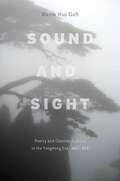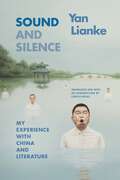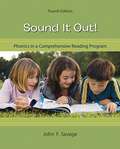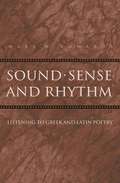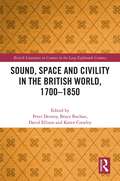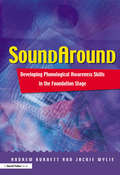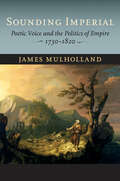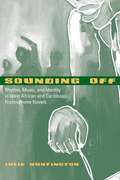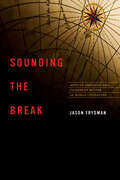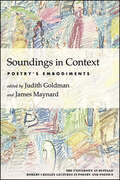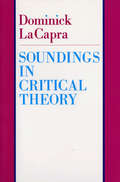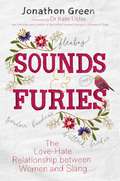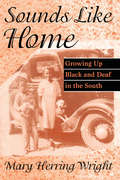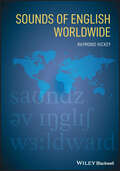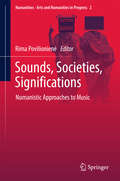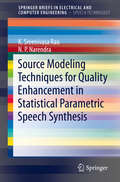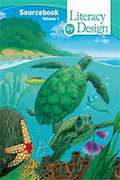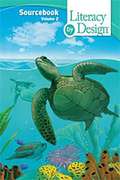- Table View
- List View
Sound and Sight: Poetry and Courtier Culture in the Yongming Era (483-493)
by Meow GohThis is the first book to examine Chinese poetry and courtier culture using the concept of shengse—sound and sight—which connotes "sensual pleasure." Under the moral and political imperative to avoid or even eliminate representations of sense perception, premodern Chinese commentators treated overt displays of artistry with great suspicion, and their influence is still alive in modern and contemporary constructions of literary and cultural history. The Yongming poets, who openly extolled "sound and rhymes," have been deemed the main instigators of a poetic trend toward the sensual. Situating them within the court milieu of their day, Meow Hui Goh asks a simple question: What did shengse mean to the Yongming poets? By unraveling the aural and visual experiences encapsulated in their poems, she argues that their pursuit of "sound and sight" reveals a complex confluence of Buddhist influence, Confucian value, and new sociopolitical conditions. Her study challenges the old perception of the Yongming poets and the common practice of reading classical Chinese poems for semantic meaning only.
Sound and Silence: My Experience with China and Literature (Sinotheory)
by Lianke YanYan Lianke is a world-renowned author of novels, short stories, and essays whose provocative and nuanced writing explores the reality of everyday life in contemporary China. In Sound and Silence, Yan compares his literary project to a blind man carrying a flashlight whose role is to help others perceive the darkness that surrounds them. Often described as China’s most censored author, Yan reflects candidly on literary censorship in contemporary China. He outlines the Chinese state’s project of national amnesia that suppresses memories of past crises and social traumas. Although being banned in China is often a selling point in foreign markets, Yan argues that there is no requisite correlation between censorship and literary quality. Among other topics, Yan also examines the impact of American literature on Chinese literature in the 1980s and 1990s. Encapsulating his perspectives on life, writing, and literary history, Sound and Silence includes an introduction by translator Carlos Rojas and an afterword by Yan.
Sound it Out!: Phonics in a Comprehensive Reading Program (Fourth Edition)
by John F. SavageThis book covers both the content of phonics and the ways in which it can be effectively integrated into a comprehensive classroom reading program. The text contains practical teaching suggestions for phonemic awareness, phonics, and spelling. The fourth edition features an increased emphasis on technology as it applies to phonics instruction, along with additional focus placed on helping children who have trouble learning acquire basic phonics skills.
Sound, Sense, and Rhythm: Listening to Greek and Latin Poetry (Martin Classical Lectures #16)
by Mark W. EdwardsThis book concerns the way we read--or rather, imagine we are listening to--ancient Greek and Latin poetry. Through clear and penetrating analysis Mark Edwards shows how an understanding of the effects of word order and meter is vital for appreciating the meaning of classical poetry, composed for listening audiences. The first of four chapters examines Homer's emphasis of certain words by their positioning; a passage from the Iliad is analyzed, and a poem of Tennyson illustrates English parallels. The second considers Homer's techniques of disguising the break in the narrative when changing a scene's location or characters, to maintain his audience's attention. In the third we learn, partly through an English translation matching the rhythm, how Aeschylus chose and adapted meters to arouse listeners' emotions. The final chapter examines how Latin poets, particularly Propertius, infused their language with ambiguities and multiple meanings. An appendix examines the use of classical meters by twentieth-century American and English poets. Based on the author's Martin Classical Lectures at Oberlin College in 1998, this book will enrich the appreciation of classicists and their students for the immense possibilities of the languages they read, translate, and teach. Since the Greek and Latin quotations are translated into English, it will also be welcomed by non-classicists as an aid to understanding the enormous influence of ancient Greek and Latin poetry on modern Western literature.
Sound, Space and Civility in the British World, 1700-1850 (British Literature in Context in the Long Eighteenth Century)
by Bruce Buchan Peter Denney David Ellison Karen CrawleyIn this collection, the essays examine the critical role that judgments about noise and sound played in framing the meaning of civility in British discourse and literature during the long eighteenth century. The volume restores the sonic dimension to conversations about civil conduct by exploring how censured behaviours and recommended practices resonated beyond the written word. As the contributors show, understanding changing perceptions and valuations of noise and sound allows us to chart how civility was understood in the context of significant political, social and cultural change, including the development of urban life, the extension of empire and the consolidation of legal procedure. Divided into three parts, Sound, Space and Civility in the British World demonstrates how both noise and sound could be recognized by eighteenth-century Britons as expressions of civility. The essays also explore the audible implications of uncivil conduct to complicate our understanding of the sonic range of politeness. The uses of sound and noise to interrogate British colonial anxieties about the distinction between civility and incivility are also investigated. Taken together, the essays identify the emergence of civility as a development that radically altered sonic attitudes and experiences, producing new notions of what counted as desirable or undesirable sound.
Sound/Spelling Cards, Grade 1 and Grade 2 (Into Reading)
by Houghton Mifflin Harcourt Publishing CompanyNIMAC-sourced textbook
Soundaround: Developing Phonological Awareness Skills in the Foundation Stage
by Andrew Burnett Jackie WylieThis practical and clear book will allow you to introduce and teach phonological awareness skills to children in the early years and up to Key Stages 1 to 2, who are struggling with their literacy levels because of weak basic skills. It provides a developmental and curriculum linked program suitable for all children, including those with special educational needs; a straightforward format that does not require specialist training yet enables staff to choose activities and confidently use them from day one; a focus on 'sounds first' leading to secure learning based on normal child development; activities which children enjoy and want to play again; and ideal preparation for literacy work at school. All staff involved with children in the Foundation Stage (and sometimes beyond) including teachers, nursery nurses, playgroup staff, SENCOs, teaching assistants, speech and language therapists and parents will be able to improve their children's early literacy skills using this approach.
Sounder (SparkNotes Literature Guide Series)
by SparkNotesSounder (SparkNotes Literature Guide) by William Armstrong Making the reading experience fun! Created by Harvard students for students everywhere, SparkNotes is a new breed of study guide: smarter, better, faster. Geared to what today's students need to know, SparkNotes provides: *Chapter-by-chapter analysis *Explanations of key themes, motifs, and symbols *A review quiz and essay topicsLively and accessible, these guides are perfect for late-night studying and writing papers
Sounding Bodies: Acoustical Science and Musical Erotics in Victorian Literature (SUNY series, Studies in the Long Nineteenth Century)
by Shannon DrauckerCan the concert hall be as erotic as the bedroom? Many Victorian writers believed so. In the mid-nineteenth century, acoustical scientists such as Hermann von Helmholtz and John Tyndall described music as a set of physical vibrations that tickled the ear, excited the nerves, and precipitated muscular convulsions. In turn, writers—from canonical figures such as George Eliot and Thomas Hardy, to New Women novelists like Sarah Grand and Bertha Thomas, to anonymous authors of underground pornography—depicted bodily sensations and experiences in unusually explicit ways. These writers used scenes of music listening and performance to intervene in urgent conversations about gender and sexuality and explore issues of agency, pleasure, violence, desire, and kinship. Sounding Bodies shows how both classical music and Victorian literature, while often considered bastions of conservatism and repression, represented powerful sites for feminist and queer politics.
Sounding Imperial: Poetic Voice and the Politics of Empire, 1730–1820
by James MulhollandSpoken words come alive in written verse.In Sounding Imperial, James Mulholland offers a new assessment of the origins, evolution, and importance of poetic voice in the eighteenth and early nineteenth centuries. By examining a series of literary experiments in which authors imitated oral voices and impersonated foreign speakers, Mulholland uncovers an innovative global aesthetics of poetic voice that arose as authors invented new ways of crafting textual voices and appealing to readers. As poets drew on cultural forms from around Great Britain and across the globe, impersonating "primitive" speakers and reviving ancient oral performances (or fictionalizing them in verse), they invigorated English poetry.Mulholland situates these experiments with oral voices and foreign speakers within the wider context of British nationalism at home and colonial expansion overseas. Sounding Imperial traces this global aesthetic by reading texts from canonical authors like Thomas Gray, James Macpherson, and Felicia Hemans together with lesser-known writers, like Welsh antiquarians, Anglo-Indian poets of colonialism, and impersonators of Pacific islanders. The frenetic borrowing, movement, and adaptation of verse of this time offers a powerful analytic by which scholars can understand anew poetry’s role in the formation of national culture and the exercise of colonial power. Sounding Imperial offers a more nuanced sense of poetry’s unseen role in larger historical processes, emphasizing not just appropriation or collusion but the murky middle range in which most British authors operated during their colonial encounters and the voices that they used to make those cross-cultural encounters seem vivid and alive.
Sounding Off: Rhythm, Music, and Identity in West African and Caribbean Francophone Novels
by Julie HuntingtonIntrigued by "texted" sonorities—the rhythms, musics, ordinary noises, and sounds of language in narratives—Julie Huntington examines the soundscapes in contemporary Francophone novels such as Ousmane Sembene's God's Bits of Wood (Senegal), and Patrick Chamoiseau's Solibo Magnificent (Martinique). Through an ethnomusicological perspective, Huntington argues in Sounding Off that the range of sounds —footsteps, heartbeats, drumbeats—represented in West African and Caribbean works provides a rhythmic polyphony that creates spaces for configuring social and cultural identities. Huntington’s analysis shows how these writers and others challenge the aesthetic and political conventions that privilege written texts over orality and invite readers-listeners to participate in critical dialogues—to sound off, as it were, in local and global communities.
Sounding the Break: African American and Caribbean Routes of World Literature (New World Studies)
by Jason FrydmanThe idea of "world literature" has served as a crucial though underappreciated interlocutor for African diasporic writers, informing their involvement in processes of circulation, translation, and revision that have been identified as the hallmarks of the contemporary era of world literature. Yet in spite of their participation in world systems before and after European hegemony, Africa and the African diaspora have been excluded from the networks and archives of world literature. In Sounding the Break, Jason Frydman attempts to redress this exclusion by drawing on historiography, ethnography, and archival sources to show how writers such as W. E. B. Du Bois, Zora Neale Hurston, Alejo Carpentier, Derek Walcott, Maryse Condé, and Toni Morrison have complicated both Eurocentric and Afrocentric categories of literary and cultural production. Through their engagement with and revision of the European world literature discourse, he contends, these writers conjure a deep history of "literary traffic" whose expressions are always already cosmopolitan, embedded in the long histories of cultural and economic exchange between Africa, Asia, and Europe. It is precisely the New World American location of these writers, Frydman concludes, that makes possible this revisionary perspective on the idea of (Old) World literature.
Soundings in Context: Poetry's Embodiments (The University at Buffalo Robert Creeley Lectures in Poetry and Poetics)
by James Maynard Judith GoldmanSoundings in Context brings together the second and third University at Buffalo Robert Creeley Lectures in Poetry and Poetics by the renowned literary and textual scholar Jerome McGann, and the innovative, prolific Canadian poet, essayist, and novelist Lisa Robertson, respectively. The volume's first half presents McGann's "Reading (I Mean Articulating) Poetry, a Multi-Player Game," with responses by Nikolaus Wasmoen and Steve McCaffery; the second presents Lisa Robertson's "Dous Chantar: Refrain for a Nightingale," with responses by Shannon Maguire and Liz Howard. Initially given at different moments and since revised, the pieces considered in the lectures range widely, moving from the Romantics and medieval troubadour poetry to T. S. Eliot, Jackson Mac Low, Jacques Rouboud, and far beyond. Still, they are collectively concerned with questions of voice, recitation, and reception in different contexts; with sonic patterning and its modes of significance; and with foregrounding an embodied experience of oral and written language as opposed to its interpretation. McGann, Robertson, and their interlocutors all propose affective, pragmatic approaches to poetry that allow it to surface as materially formative, alive and lived. Reading their contributions together offers an opportunity to see how these values present themselves in differing cultures of poetic scenography across space and time.
Soundings in Critical Theory
by Dominick Lacapra"Dominick LaCapra is unequalled in his ability to bring theoretical concerns that are associated with literary theory to the attention of historians. He is responsible for enlivening the discipline of history and compelling historians to rethink their foundational assumptions, which normally go unquestioned."—Mark Poster, University of California, Irvine
Sounds & Furies: The Love-Hate Relationship between Women and Slang
by Jonathon Green'When it comes to distaff dirtiness, mainstream males such as Dickens and Dekker make easy pickings, but Green finds the greatest treasures when he mudlarks on the margins. In Sounds & Furies, he has dredged up some gems.'Emma Byrne, Spectator'From fishwives to flappers and from music hall performers to Mumsnetters, women have indeed made contributions to the slang vocabulary of English; by bringing together so much fascinating material about their words and their worlds, this book makes its own contribution to the history of both women and language.'Professor Deborah Cameron, Professor of Language and Communication, Worcester College, University of Oxford'Green comprehensively disproves that slang is inherently masculine. Mumsnetters and bulldaggers, flappers and slappers, shicksters and hash-slingers all put in their claims as slang-users in their own right in this entertaining and thought-provoking book. Any writer venturing into the contentious area of women as users, creators or objects of slang from now on will look to Green for guidance or for arguments.'Julie Coleman, author of The Life of SlangSlang. The ultimate in man-made languages. The male gaze made verbal. A world where words for intercourse mean 'man hits woman', the penis is a gun, a knife or club and the vagina a terrifying tunnel. Possibly with teeth. Two thousand words for woman and every one a put-down. Even 'mother' is simply short for the grossest of obscenities.Thus the story, now and for several hundred years. But stories are just that and perhaps there's an alternative.In this book Jonathon Green, the leading collector of English-language slang and drawing on forty years of research in the field, asks whether women have another role to play. As slang's active, positive, rebellious subject, rather than its endlessly derided, submissive object.Sounds & Furies represents a quest to overturn a long-established, but far from invulnerable belief system. To show that throughout a recorded history that starts with Chaucer's bawdy, mouthy and magnificently self-willed Wife of Bath and carries on through a cast of working girls and villainesses, playwrights and bestselling authors, shop-girls and fish-wives and through to the modern, on-line worlds of Mumsnet and Tinder, women have always made slang their own.If slang has always been the language of the margins, then women, for all their numbers, have also been consigned to the margins. Those days, it is ever more clear, are over. If slang has a role then it is to represent us at our most human. That may not mean 'admirable' but it surely means 'true'. And humanity is on offer to everyone, whatever gender they may claim. That goes for language, whatever its variety, too.From the foreword by sex historian Kate Lister:'Patriarchal cultures have understood women, controlled women, and marginalised women. But, this book also reveals that it is the rebellious women who used slang: the fishwives, the scolds, the whores, and the harridans. Long may they continue to do so.'
Sounds Fascinating
by Wells J. C. Lhinton Davidson J. C. Davidson LhintonHow do you pronounce biopic, synod, and Breughel? - and why? Do our cake and archaic sound the same? Where does the stress go in stalagmite? What's odd about the word epergne? Pontcysyllte is obviously Welsh, but Penge is Welsh too! How cool is Caol in the Highlands of Scotland? What can Wesley's hymns tell us about sound change in English? How do people pronounce Wrocław in Poland? How can anyone manage to say Gdynia as just two syllables? Why is the village of Frith in the island of Montserrat usually pronounced as if spelt Frits? What embarrassing faux pas in English did a Russian conglomerate make? Should I bild a cubbard instead of building a cupboard? How should we capitalize an exclamation mark, and why might we need to? What's a depressor consonant? As a finale, the author writes a letter to his 16-year-old self.
Sounds Interesting
by J. C. Wells Lhinton DavidsonHow do you pronounce omega, tortoise and sloth? And why? Do charted and chartered sound the same? How do people pronounce the names Charon, Punjab, and Sexwale? In this engaging book, John Wells, a world-renowned phonetician and phonologist, explores these questions and others. Each chapter consists of carefully selected entries from Wells' acclaimed phonetics blog, on which he regularly posted on a range of current and widely researched topics such as pronunciation, teaching, intonation, spelling, and accents. Based on sound scholarship and full of fascinating facts about the pronunciation of Welsh, Swedish, Czech, Zulu, Icelandic and other languages, this book will appeal to scholars and students in phonetics and phonology, as well as general readers wanting to know more about language. Anyone interested in why a poster in Antigua invited cruise ship visitors to enjoy a game of porker, or what hymns can tell us about pronunciation, should read this book.
Sounds Like Home: Growing Up Black and Deaf in the South
by Mary Herring WrightMary Herring Wright's memoir adds an important dimension to the current literature in that it is a story by and about an African American deaf child. The author recounts her experiences growing up as a deaf person in Iron Mine, North Carolina, from the 1920s through the 1940s. Her story is unique and historically significant because it provides valuable descriptive information about the faculty and staff of the North Carolina school for Black deaf and blind students from the perspective of a student as well as a student teacher. In addition, this engrossing narrative contains details about the curriculum, which included a week-long Black History celebration where students learned about important Blacks such as Madame Walker, Paul Laurence Dunbar, and George Washington Carver. It also describes the physical facilities as well as the changes in those facilities over the years. In addition, Sounds Like Home occurs over a period of time that covers two major events in American history, the Depression and World War II. Wright's account is one of enduring faith, perseverance, and optimism. Her keen observations will serve as a source of inspiration for others who are challenged in their own ways by life's obstacles.
Sounds of English Worldwide
by Raymond HickeyAn in-depth exploration of the sound systems of varieties of English around the world, written by a renowned authority in the field In Sounds of English Worldwide, Raymond Hickey delivers a rigorous overview of the sound systems of varieties of English throughout the world. Beginning with an overview of the history and contexts of global varieties of English, this book guides readers through the spread of English during the colonial era leading up to the present day. The second section of the book broadly considers developments in the English-speaking world, accounting for the factors that triggered regional changes and resulted in diverse scenarios for English, including language contact and shift, new dialect formation , and the use of English in non-anglophone contexts. To assist students in learning how to approach the study of varieties of English, this valuable text addresses research questions of general interest to linguists and explores a variety of fieldwork methods commonly used by researchers in the area. This useful book offers: A thorough introduction to English today, including its geographical and social distribution, focusing on variation and change around the world Practical discussions of key changes in late modern English that determined the unique phonetic profile of different varieties of the language In-depth examination of present-day scenarios and how they might pan out in the future development of English, considering the many factors which may shape global forms of the language Includes useful summaries of varieties of English with a glossary and timeline, providing a quick reference of the key features of English around the world for students Considers research issues and methods to aid students in applying the material of the book to their own studiesPerfect for graduate students, advanced undergraduate students, and researchers studying varieties of Englishes, Sounds of English Worldwide will earn a place in the libraries of linguists and students studying Englishes worldwide from a sociolinguistic perspective as well as langague contact , bilingualism, the rise of new varieties along with English phonetics and phonology more generally.
Sounds, Societies, Significations
by Rima PovilionienėThis edited book covers many topics in musicological literature, gathering various approaches to music studies that encapsulate the vivid relation music has to society. It focusses on repertoires and geographical areas that have not previously been well frequented in musicology. As readers will see, music has many roles to play in society. Music can be a generator of social phenomena, or a result of them; it can enhance or activate social actions, or simply co-habit with them. Above all, music has a stable position within society, in that it actively participates in it. Music can either describe or prescribe social aspects; musicians may have a certain position/role in society (e. g. , the "popstar" as fashion leader, spokesman for political issues, etc. ). Depending on the type of society, music may have a certain "meaning" or "function" (music does not mean the same thing everywhere in the world). Lastly, music can define a society, and it is not uncommon for it to best define a particular historical moment. Case-studies in this work provide visibility for musical cultures that are rarely exposed in the dominant musicological discourse. Several contributions combine musicological analysis with "insider-musician" points of view. Some essays in the collection address the cultural clash between certain types of music/musicians and the respective institutional counterparts, while certain contributing authors draw on experimental research findings. Throughout this book we see how musics are socially significant, and - at the same time - that societies are musically significant too. Thus the book will appeal to musicologists, cultural scholars and semioticians, amongst others.
Source Modeling Techniques for Quality Enhancement in Statistical Parametric Speech Synthesis (SpringerBriefs in Speech Technology)
by K. Sreenivasa Rao N. P. NarendraThis book presents a statistical parametric speech synthesis (SPSS) framework for developing a speech synthesis system where the desired speech is generated from the parameters of vocal tract and excitation source. Throughout the book, the authors discuss novel source modeling techniques to enhance the naturalness and overall intelligibility of the SPSS system. This book provides several important methods and models for generating the excitation source parameters for enhancing the overall quality of synthesized speech. The contents of the book are useful for both researchers and system developers. For researchers, the book is useful for knowing the current state-of-the-art excitation source models for SPSS and further refining the source models to incorporate the realistic semantics present in the text. For system developers, the book is useful to integrate the sophisticated excitation source models mentioned to the latest models of mobile/smart phones.
Sourcebook (Rigby Literacy by Design #Volume 1, Grade 3)
by Linda Hoyt Michael Opitz Sharon Hill Robert Marzano Yvonne Freeman David FreemanNIMAC-sourced textbook
Sourcebook (Rigby Literacy by Design #Volume 1, Grade 5)
by Linda Hoyt Michael Opitz Sharon Hill Robert Marzano Yvonne Freeman David FreemanNIMAC-sourced textbook
Sourcebook Volume 1 [Grade 4]
by Linda Hoyt Michael Opitz Sharon Hill Robert Marzano Yvonne Freeman David FreemanNIMAC-sourced textbook
Sourcebook Volume 2 [Grade 3]
by Linda Hoyt Michael Opitz Sharon Hill Robert Marzano Yvonne Freeman David FreemanNIMAC-sourced textbook
